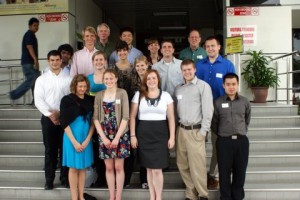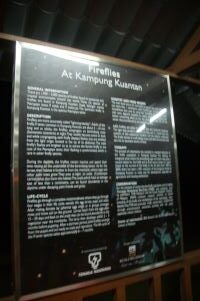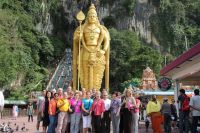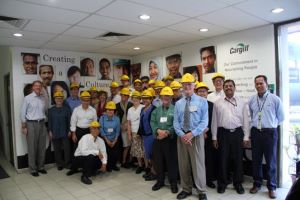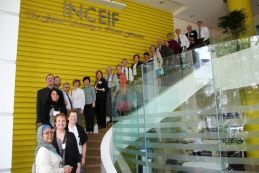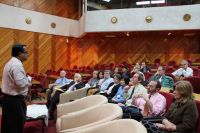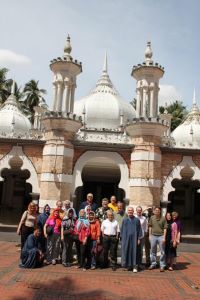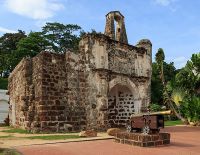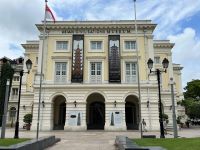Salamat Pagi from Kuala Lumpur
The morning paper (a cross between the National Enquirer and USA Today) has been following a local controversy that tells a lot about Malaysia. On Saturday, a Malay paper had a headline that asked, “Can Malaysia become a Christian country, with a Christian Prime Minister.” The article outlined a cabal of Christian organizations that were purportedly plotting such an event. Today’s paper assures its readers that the possibility cannot happen, in part because the constitution guarantees that Malaysia will protect its Muslim majority, and the “constitution cannot be changed.”
That the occurrence can be feared is a measure of the multiethnic society that Malaysia has become, a product of its history, especially under the British, who brought in a variety of ethnic groups–especially the Chinese and Indians to milk the rich resources of the country. Today, that’s oil (which generates 40% of the revenue) and palm oil (which requires about 1 million imported workers, mostly from Indonesia), but historically meant tin mines and rubber. The 1Malaysia tagline is a direction the country has sought since independence, but the scars from the past (there were major race riots in the 60s) are still present. As the latest flap made clear. Essentially, the government is Malay dominated (UMNO, the United Malay political party celebrated its 65th anniversary yesterday, which meant 65 years of political domination, about a third of it under Mahathir Mohammed, a strong-willed, British-educated Prime Minister, who for a long time questioned the United States and really remade the country–Putrajaya, the new capital; the Petronas Towers, at the time the highest building in the world; Cyberjaya, a high-tech corridor, etc. The Chinese are dominant in the economy, and the Indians, as our guide Mr. Singh put it, are in between. The proportions are about 60% Malay, 30% Chinese, and 10% Indian. My understanding is that Bahasa is the official language (shared with Indonesia, whence came many of the original rulers of the country–the Sultanate of Malacca was a dominant regional power until the Portuguese ended its existence in 1511), but that Mandarin Chinese and Tamil are pretty much required in the schools, for those of Chinese descent (most of whom are probably Hakka or Hokkien speakers from South China) or Indian (Tamil is one of 14 official Indian languages).
I have sought to emphasize the Muslim nature of the country to our students, and it is more obvious here than in Penang (which, as one of the Straits Settlements, together with Malacca and Singapore) had its own British government, and even today have no Sultan and are administered separately. It was one of the reasons we visited the Islamic Art Museum of Malaysia, a stunning building with stunning artifacts, many of them from the Ottoman Empire that last May was one of our concerns in Eastern Europe; the borderlands/boundaries between East and West stretched from Vienna to China. It was one of the reasons we visited the Palace (originally a Chinese home, large enough to accommodate his seven wives), now occupied on a rotating basis by one of the Sultans, who is king of the country for five years. Even the Petronas tower is symbolic of Muslim 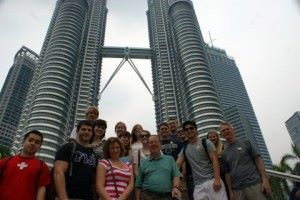 dominance in its Islamic design. Muslims here operate under Sharia law (there is a civil law for non-Muslims), and as I recall, if you marry a Muslim, you convert. It seems to be a milder form than in the Middle East, but it still is a Muslim country, determined (ala Mahathir) to play an important role as a progressive Muslim force, a goal which is pretty impressive for a country of 29 million.
dominance in its Islamic design. Muslims here operate under Sharia law (there is a civil law for non-Muslims), and as I recall, if you marry a Muslim, you convert. It seems to be a milder form than in the Middle East, but it still is a Muslim country, determined (ala Mahathir) to play an important role as a progressive Muslim force, a goal which is pretty impressive for a country of 29 million.
What we did Thursday confirmed much of the above. We took a morning trip to the new capital, Putrajaya, named for the first prime minister of Malaysia, which is an impressive city of up to half a million people. The parliament, the palace of the sultan of Selangor (who gave the land for the city), the Prime Minister’s offices, and the new mosque establish Putrajaya as a contender for the new caliphate or at least a contender for influence of the world stage as an avowedly Muslim country. When I compare it with the buildings in Kuala Lumpur, built a century earlier as examples of Turko-Moorish architecture designed by British architects, I’m more reminded of the splendor of the Moghul Empire in India.
The other visit was to an agricultural park in Putrajaya, that has a “live kitchen” (as the sign described the fresh food place), and the panoply of agricultural products that helps make Malaysia a gourmet’s paradise. If you love fresh fruit, you’ll be comfortable here, with everything from rambutan to durian. One highlight was a stand of rubber trees (Putrajaya had been a rubber plantation). Malaysia had, at one time, been the largest producer of rubber, but is now number 4.
 The evening was capped by a cultural show featuring Malay food and Malay dancing. With the gamelan, I could have been in Indonesia, but that is where the Malays, especially the Sultan of Malacca, came from.
The evening was capped by a cultural show featuring Malay food and Malay dancing. With the gamelan, I could have been in Indonesia, but that is where the Malays, especially the Sultan of Malacca, came from.
Tomorrow morning we leave Malaysia for Singapore, and I bet that by 5 p.m. tomorrow, the Republic of Singapore will become my favorite country in Asia.
I hope you have a pleasant day.
